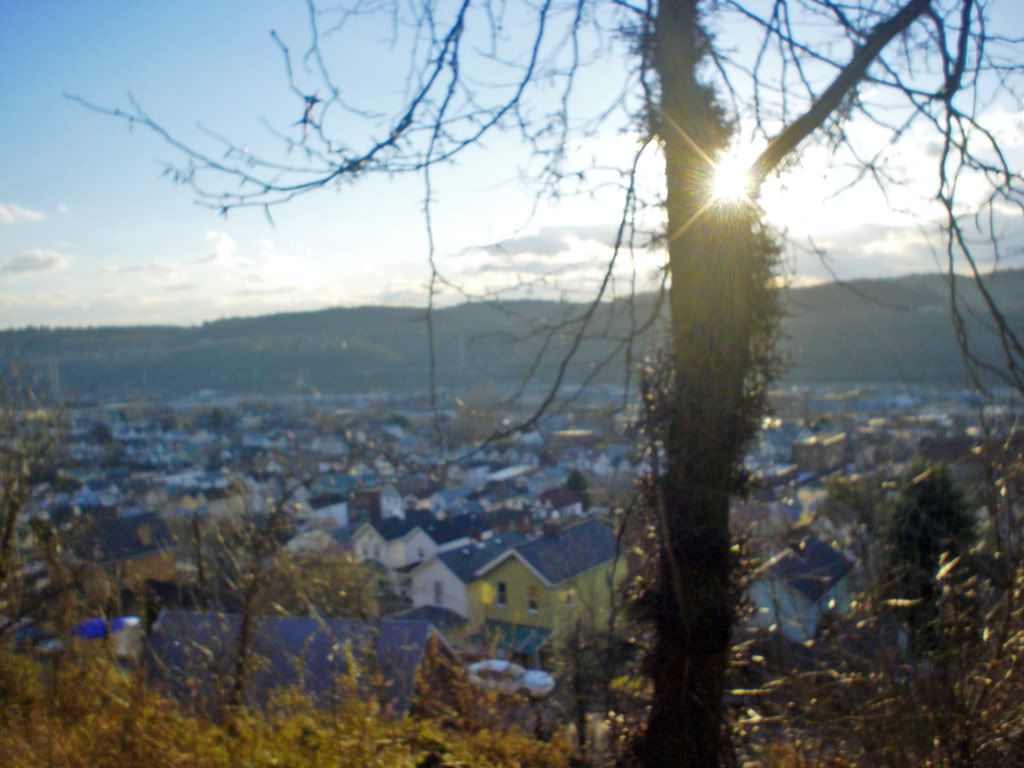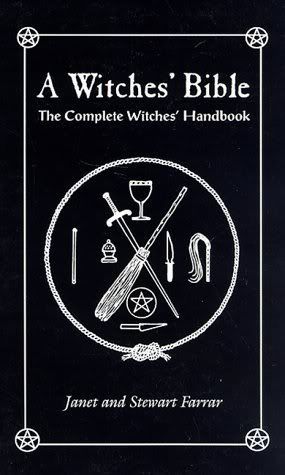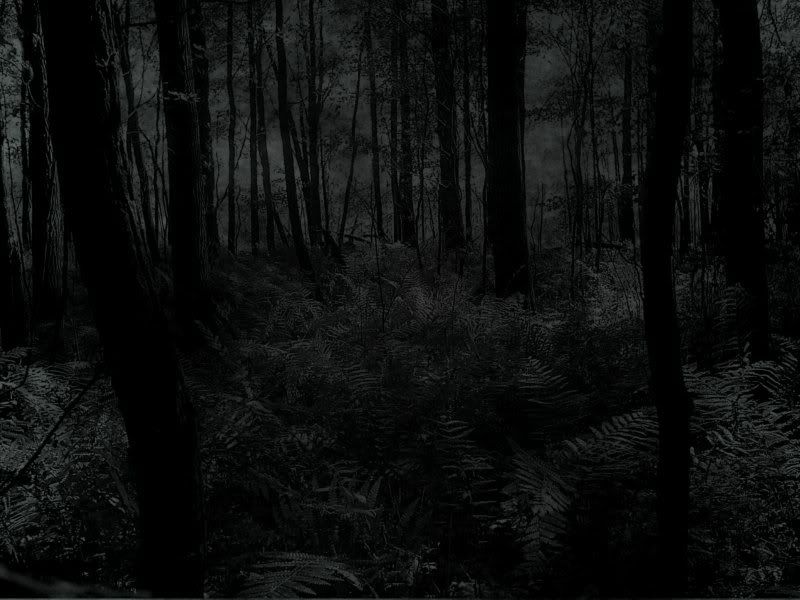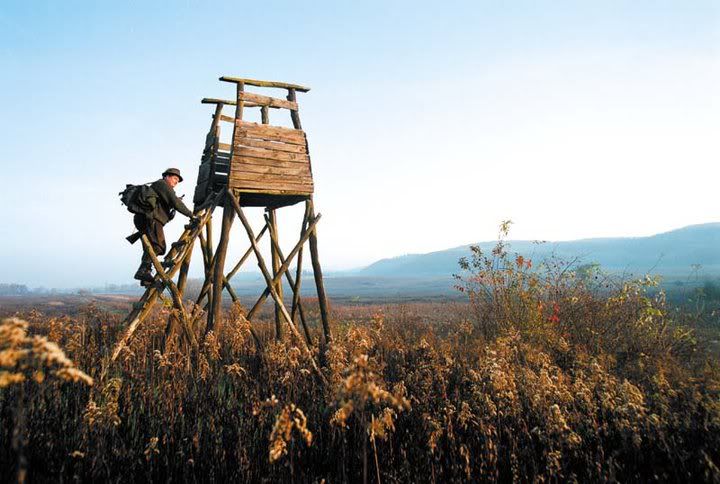Now another simple article, taking the "pro-hunting" stance:
Charlottesville, Virginia
THE call to forge deeper connections with the food we eat has pulled thousands to the nation’s farmers’ markets, sprouted a million backyard seedlings and jump-started an interest in scratch baking, canning and other county-fair pursuits.
Now add hunting to the list. Novice urban hunters are forming classes and clubs to learn skills that a few generations ago were often passed down from parent to child.
Jackson Landers, an insurance broker by day, teaches a course here called Deer Hunting for Locavores. Mr. Landers, 31, started the classes earlier this year for largely urban adults who, like him, did not grow up stalking prey but have gravitated to harvesting and cooking their own game.
He tailored his course to food-obsessed city people with lessons on deer biology, habitat and anatomy, and rounded out his students’ education with field trips to a firing range to practice shooting and a session on butchery and cooking. One of the last lessons covered field dressing a freshly killed deer. As the students gathered around, Mr. Landers produced a hunting knife and explained its gut-hook feature, which promised to open the deer “like a zipper.”
“I’d never fired a gun before,” said Michael Davis, 44, a graphic designer and a student in the class. “I grew up in Southern California. We surfed, we didn’t hunt.”
But Mr. Davis, a self-described foodie, said he needed to understand what it means to hunt for food.
“I think going through my life without at least experiencing that most primal thing of hunting would be cheating,” he said.
It was a taste for wild boar that spurred Nick Zigelbaum, 26, and Nick Chaset, 27, to form a hunting and dining club in San Francisco that they call the Bull Moose Hunting Society. The society, founded in 2007, was designed to appeal to young urban residents looking to expand their horizons.
The club now has roughly 55 dues-paying members, many of them in their 20s and 30s, who hunt for boar, pheasant and waterfowl together. They share local hunting knowledge and the spoils of a good day in the field at semi-regular events they call boar-b-ques and wild food dinners.
Mr. Chaset, who is now attending graduate business school in Washington, D.C., recently established a chapter of the club there. The founders hope that someday they’ll have a chapter in every major American urban area.
Nationwide, the number of hunters has been in decline for decades. The country’s shift from rural to urban life is the main reason, said Mark Damian Duda, executive director of Responsive Management, a survey and research firm that specializes in natural resources and outdoor recreation issues.
According to his firm’s research, only 22 percent of hunters now say they hunt primarily for food. Most say they do so for recreation or to spend time with their families.
“Thirty years ago it was about half the hunters who were hunting for food,” Mr. Duda said.
The connection never completely faded, though. Some American chefs who grew up with rifles in their hands have long been passionate about wild game, even if the law forbids them from serving it in their restaurants. The subject has also been taken up recently by the writers Michael Pollan, who shoots a wild boar in “The Omnivore’s Dilemma,” and Steven Rinella, who chronicled his quest to kill a wild American bison in “American Buffalo.” But until recently, tree stands and Mossy Oak camouflage were rarely mentioned in the same breath as, say, heirloom tomatoes.
Anthony Licata, editor of Field & Stream magazine, said he wasn’t surprised that a new generation of eaters was discovering what traditional hunters have known all along: “There’s nothing more organic and free range than meat you hunt for yourself and your family,” he said.
Mr. Licata, who is 35 and lives in New Jersey, said he thought interest in hunting among young urban locavores was bound to grow. “When you do hunt and if you’re lucky enough to fill your freezer with venison and feed your family, it’s a powerful thing,” he said. “They aren’t going to want to stop.”
Mr. Landers, who tries to take Virginia’s full limit of six deer a year, agreed. For the cost of the necessary licenses, $36.50, he said he can stock his freezer with nearly free protein.
He also argued that for the environmentally conscious, hunting is fairly carbon neutral.
“If you can shoot a deer in your own backyard, butcher it there, that’s zero food miles,” he said.
A recent convert to hunting, he became interested in wild game a few years ago when he inherited his great-grandfather’s hunting rifle. He read up on deer management, queried his in-laws, many of whom are lifelong hunters, and was soon putting venison on the table.
Like many people, he’d also become concerned about large scale agricultural methods, the use of antibiotics in livestock and the ethics of raising animals in tight quarters. Hunting seemed like a good alternative.
“I felt bad about meat, but not so bad that I was willing to give it up,” he said.
Before founding the Bull Moose Hunting Society, Mr. Zigelbaum and Mr. Chaset wanted a closer connection with their food, but finding information about hunting in the Bay Area was daunting.
Mr. Chaset recalled searching for a suitable wild boar hunting weapon at a gun shop in the Mission District of San Francisco. The staff tried to convince him that a pistol would be fine. He left with the shop’s only rifle, a .308, which he used to fell his first boar in the hills of Mendocino County, an experience he described as “an epiphany.”
“I got this strong sensation of the cycle of life,” he said. It didn’t hurt that he thought the taste of the boar was amazing.
Mr. Zigelbaum said the meat, which tends to be darker and denser than domesticated pork, was “lean, but tasted like bacon.”
He’s heading to the south of France soon where he hopes to study traditional charcuterie methods. Wild boar prosciutto, he said, would be “awesome.”
Their club, named with a nod to the hunter and conservationist Theodore Roosevelt, is as much about rural foodways as it is about environmentalism. Mr. Zigelbaum, who is a consultant to the Natural Resources Defense Council, the environmental group, noted that the wild boar is an invasive species whose rampant rooting has caused considerable damage to California rangeland.
In Virginia, and across much of the East, the white-tailed deer population has shot up dramatically, causing fatal auto accidents, damaging crops and gardens and out-competing other animals for food and habitat. State game agency officials have supported Mr. Landers’s efforts to introduce new hunters and they plan to supply him with deer to demonstrate field dressing and butchery even after the season.
Few of the 20 students who have signed up for his class, which he advertised on his blog and a site for local news, had firearms experience or had ever gutted a deer. But all were lured by the idea of harvesting wild food from nearby woods and providing it for their friends and family. A few thought they were missing a part of the human experience, and others saw road kill as wasted meat littering the sides of the highway at a time when many are struggling to pay grocery bills.
On a recent Saturday, Mr. Landers convened a half-dozen of his students for an impromptu class on proper field dressing.
Mr. Landers is a fan of quick basic field butchery, which he says reduces the gaminess usually associated with venison. He also favors a large cooler to transport meat back to possibly squeamish urban areas, especially for those who don’t have a truck.
Soon the students, working in tandem to clean the animal, began to see the progress of their work.
“It really began to look like meat pretty quickly,” said Brian Donato, 43, who helped to gut, skin and break down the deer into quarters, loins and scraps for sausage.
For Ted Peters, 77, hunting seemed like a natural solution to an overabundant deer population, which had begun to impede another local food pursuit.
“They eat my garden, so I thought maybe I should eat them,” he said.
The deer was the centerpiece of a dinner held the next evening at the home of one of Mr. Landers’s students. In a graduation of sorts, they balanced glasses of local wine and plates of homemade spaetzle with slices of spice-rubbed, pinwheeled and beer-braised venison backstrap, a prized cut that runs along a deer’s spine.
Eddie Harrison, 16, the youngest student in the class, who attended with his father, declared the meat “some of the best I’ve ever had,” and compared it to a dish from Mas, a popular Charlottesville restaurant.
In a corner, Scott Swanson and another student made plans for post-graduation hunts. Two weeks later, Mr. Swanson, who keeps a version of the popular bar video game “Deer Hunter” on his iPhone, managed to get “a nice little doe,” which filled the trunk of his car with about 50 to 60 pounds of bone-in meat.
“From the time I pulled the trigger and the time I had it my trunk was just under two hours,” said Mr. Swanson, 31, a technical project manager at a Web development company.
He said he was planning to slice the backstrap into medallions to marinate and roast them over his grill.
For Nina Burke, 50, a systems administrator, who made the two-hour drive from Fredericksburg, Va., to Charlottesville to attend Mr. Landers’s classes, it was about the flavor.
“I really like venison,” she said, explaining she’d often exchanged baked goods for the fine-grained low-fat meat.
“This class was the chance of a lifetime,” she said. “I always thought that the only way I would get a deer was with my car.”
**************************************************
.














